Sustainability and Chinese Urban Settlements: Extending the Metabolism Model of Emergy Evaluation
Abstract
:1. Introduction
2. The Pre- and Post-Reform Settlements
3. Materials and Methods
3.1. Urban Metabolism Framework and MFA Methodology
3.2. Study Area and Data
3.2.1. Study Area
3.2.2. Data Collection
4. Results
4.1. Socioeconomic and Built-Environment Characteristics of the Two Settlements
4.2. Preliminary Analysis of Metabolism Processes through Flows Accounting
4.2.1. Fuels and Electricity Energy Flows
4.2.2. Material Flows
4.2.3. Non-Material Flows
4.2.4. Outputs
4.3. Analysis Based on Emergy Synthesis
4.3.1. System Diagram
4.3.2. Emergy Analysis
4.4. Emergy Flow Structure of the Two Settlements
4.5. Metabolism Sustainability Indices Development and Comprehensive Analysis
5. Discussion
6. Conclusions
Supplementary Materials
Acknowledgments
Author Contributions
Conflicts of Interest
References
- UNDP (UN Population Division). World Urbanization Prospects: The 2007 Revision. Executive Summary; UN Population Division: New York, NY, USA, 2008; p. 2. [Google Scholar]
- Huang, S.L.; Kao, W.C.; Lee, C.L. Energetic mechanisms and development of an urban landscape system. Ecol. Model. 2007, 201, 495–506. [Google Scholar] [CrossRef]
- Codoban, N.; Kennedy, C.A. Metabolism of neighborhoods. J. Urban Plan. Dev. 2008, 134, 21–31. [Google Scholar] [CrossRef]
- Golubiewski, N. Is there a metabolism of an urban ecosystem? An ecological critique. AMBIO A J. Hum. Environ. 2012, 41, 751–764. [Google Scholar] [CrossRef] [PubMed]
- Chrysoulakis, N.; Lopes, M.; San José, R.; Grimmond, C.S.B.; Jones, M.B.; Magliulo, V.; Klostermann, J.E.M.; Synnefa, A.; Mitraka, Z.; Castro, Z.A.; et al. Sustainable urban metabolism as a link between bio-physical sciences and urban planning: The bridge project. Landsc. Urban Plan. 2013, 112, 100–117. [Google Scholar] [CrossRef]
- Baccini, P.; Brunner, P.H. Metabolism of the Anthroposphere: Analysis, Evaluation, Design, 2nd ed.; The MIT Press: Cambridge, MA, USA, 2012; pp. 81–172. [Google Scholar]
- Dempsey, N.; Brown, C.; Raman, S.; Porta, S.; Jenks, M.; Jones, C.; Bramley, G. Elements of urban form. In Dimensions of the Sustainable City; Jenks, M., Jones, C., Eds.; Springer: Dordrecht, The Netherland, 2009; pp. 21–51. [Google Scholar]
- Kennedy, C.; Cuddihy, J.; Engel-Yan, J. The changing metabolism of cities. J. Ind. Ecol. 2007, 11, 43–59. [Google Scholar] [CrossRef]
- OECD. Innovative Policies for Sustainable Urban Development—The Ecological City; OECD: Paris, France, 1996; pp. 12–20. [Google Scholar]
- Newman, P.W.G. Sustainability and cities: Extending the metabolism model. Landsc. Urban Plan. 1999, 44, 219–226. [Google Scholar] [CrossRef]
- Huang, S.L.; Hsu, W.L. Material flow analysis and emergy evaluation of Taipei’s urban construction. Landsc. Urban Plan. 2003, 53, 145–161. [Google Scholar] [CrossRef]
- Wolman, A. The metabolism of cities. Sci. Am. 1965, 213, 179–190. [Google Scholar] [CrossRef] [PubMed]
- Rappaport, R.A. The flow of energy in an agricultural society. Sci. Am. 1971, 224, 117–133. [Google Scholar]
- Hanya, T.; Ambe, Y. A study on the metabolism of cities. Sci. Better Environ. 1977. [Google Scholar] [CrossRef]
- Newcombe, K.; Kalina, J.D.; Aston, A.R. The metabolism of a city: The case of Hong Kong. Ambio 1978, 7, 3–15. [Google Scholar]
- Kennedy, C.; Pincetl, S.; Bunje, P. The study of urban metabolism and its applications to urban planning and design. Environ. Pollut. 2011, 159, 1965–1973. [Google Scholar] [CrossRef] [PubMed]
- Darton, R.C. Scenarios and metrics as guides to a sustainable future: The case of energy supply. Process Saf. Environ. Prot. 2003, 81, 295–302. [Google Scholar] [CrossRef]
- Balta, M. Exergetic cost analysis and sustainability assessment of various low exergy heating systems. Energy Build. 2012, 55, 721–727. [Google Scholar] [CrossRef]
- Balta, M.; Dincer, I.; Hepbasli, A. Performance and sustainability assessment of energy options for building HVAC applications. Energy Build. 2010, 42, 1320–1328. [Google Scholar] [CrossRef]
- Kim, J.T.; Todorovic, M.S. Towards sustainability index for healthy buildings—Via intrinsic thermodynamics, green accounting and harmony. Energy Build. 2013, 62, 627–637. [Google Scholar] [CrossRef]
- Ortiz, O.; Castells, F.; Sonnemann, G. Sustainability in the construction industry: A review of recent developments based on LCA. Constr. Build. Mater. 2009, 23, 28–39. [Google Scholar] [CrossRef]
- Reza, B.; Sadiq, R.; Hewage, K. Emergy-based life cycle assessment (Em-LCA) of multi-unit and single-family residential buildings in Canada. Int. J. Sustain. Built. Environ. 2014, 3, 207–224. [Google Scholar] [CrossRef]
- Pan, H.X.; Shen, Q.; Zhang, M. Influence of urban form on travel behaviour in four neighbourhoods of Shanghai. Urban Stud. 2009, 46, 275–294. [Google Scholar]
- Wang, D.; Chai, Y. The jobs-housing relationship and commuting in Beijing, China: The legacy of Danwei. J. Transp. Geogr. 2009, 17, 30–38. [Google Scholar] [CrossRef]
- Zhou, S.H.; Lan, L.Y. The situation and transition of jobs-housing relocation in Guangzhou, China. Acta Geogr. Sin. 2010, 65, 191–201. [Google Scholar]
- Ma, J.; Liu, Z.; Chai, Y. Urban form and carbon emissions from urban transport: Based on the analysis of individual behavior. Urban Plan. Int. 2013, 28, 19–24. [Google Scholar]
- Wang, Y.P.; Murie, A. Commercial housing development in urban China. Urban Stud. 1999, 36, 1475–1494. [Google Scholar] [CrossRef] [PubMed]
- Liu, J.R.; Wang, R.S.; Yang, J.X. Metabolism and driving forces of Chinese urban household consumption. Popul. Environ. 2005, 26, 325–341. [Google Scholar] [CrossRef]
- Costanza, R.; D’Arge, R.; Groot, R.D.; Farber, S.; Grasso, M.; Hannon, B.; Limburg, K.; Naeem, S.; O’Neill, R.V.; Paruelo, J.; et al. The value of the world’s ecosystem services and natural capital. Nature 1997, 387, 253–260. [Google Scholar] [CrossRef]
- Sciubba, E.; Ulgiatib, S. Emergy and exergy analyses: Complementary methods or irreducible ideological options? Energy 2005, 30, 1953–1988. [Google Scholar] [CrossRef]
- Crawley, M.J.; Odum, H.T. Systems ecology; An introduction. J. Anim. Ecol. 1984. [Google Scholar] [CrossRef]
- Balocco, C.; Papeschi, S.; Grazzini, G.; Basosi, R. Using exergy to analyze the sustainability of an urban area. Ecol. Econ. 2004, 48, 231–244. [Google Scholar] [CrossRef]
- Xiamen Construction and Administration Bureau. The Development of Social Security Housing (2007–2010). Available online: http://www.xmzfbz.gov.cn/develop/fzgh2.htm (accessed on 20 December 2008).
- Li, D.; Wang, R.S. Hybrid Emergy-LCA (HEML) based metabolic evaluation of urban residential areas: The case of Beijing. Chin. Ecol. Complex. 2009, 6, 484–493. [Google Scholar] [CrossRef]
- Planning for Qianpu Residential Area. Available online: http://info.tgnet.cn/Detail/200801252005022573/ (accessed on 15 January 2009).
- Property Services Scheme for XMU Faculty. Available online: http://zchqc.xmu.edu.cn/show.asp?id=112 (accessed on 15 January 2009).
- Cui, S.H.; Niu, H.B.; Wang, W.; Zhang, G.Q.; Gao, L.J.; Lin, J.Y. Carbon footprint analysis of the Bus Rapid Transit (BRT) system: A case study of Xiamen City. Int. J. Sustain. Dev. World 2010, 17, 329–337. [Google Scholar] [CrossRef]
- Li, D.; Wang, R.S.; Zhou, C. Leap based comprehensive scenario analysis of Emergy evaluation on urban residential area. J. Grad. Sch. Chin. Acad. Sci. 2009, 26, 72–82. (In Chinese) [Google Scholar]
- Liu, T.X.; Hu, D. Environmental impact of residential building construction in Beijing: 1949–2003: Assessing the construction materials’ environmental impact by LCA. J. Grad. Sch. Chin. Acad. Sci. 2006, 23, 231–241. (In Chinese) [Google Scholar]
- Shen, F.F. Recycle of ferrous metal in scraped cars. Chin. Resour. Compr. Util. 2000, 8, 12–16. (In Chinese) [Google Scholar]
- Fang, H.F.; Huang, Y.H.; Wang, K. Research on recovery technology of non-metallic materials of ELV. Mater. Technol. Equip. 2007, 28, 45–49. (In Chinese) [Google Scholar]
- Xiamen Statistical Yearbook 2009. Available online: http://www.stats-xm.gov.cn/2009/ (accessed on 29 August 2009).
- Xiamen Municipal Prices Reports. Available online: http://www.xmwj.com/Market/schq_list.aspx?id=56&type=0 (accessed on 4 October 2009).
- Handbook of Xiamen Bus Line. Available online: http://xmgjt.com/gy.asp?id=45 (accessed on 12 April 2009).
- BRT: Reducing the Psychological Distance between Downtown and Suburban. Available online: http://www.jimei.gov.cn/myoffice/documentComm.do?docId=D21843 (accessed on 29 August 2009).
- Lu, K.A. Status quo and comprehensive utilization of refuse produced from construction and removal of buildings in China. Constr. Technol. 1999, 28, 44–45. (In Chinese) [Google Scholar]
- Gao, P.Q. Management and integrated treatment planning of municipal domestic waste in Xiamen City. Environ. Sanit. Eng. 2007, 15, 8–11. (In Chinese) [Google Scholar]
- Lecture information of Xiamen University. Available online: http://lecture.xmu.edu.cn/ (accessed on 29 August 2009).
- XMU Measures for the Implementation and Assessment of XMU Faculty Appointment. Available online: http://rsc.xmu.edu.cn/view_article.asp?id=132 (accessed on 29 August 2009).
- Meillaud, F.; Gay, J.B.; Brown, M.T. Evaluation of a building using the emergy method. Sol. Energy 2005, 79, 204–212. [Google Scholar] [CrossRef]
- Odum, H.T. Environmental Accounting: Emergy and Environmental Decision Making; John Wiley & Sons Inc.: New York, NY, USA, 1996; pp. 1–15. [Google Scholar]
- Huang, S.L.; Lee, C.; Chen, C.W. Socioeconomic metabolism in Taiwan: Emergy synthesis versus material flow analysis. Resour. Conserv. Recycl. 2006, 48, 166–196. [Google Scholar] [CrossRef]
- Pulselli, R.; Simoncini, E.; Ridolfi, R.; Bastianoni, S. Specific emergy of cement and concrete: An energy-based appraisal of building materials and their transport. Ecol. Indic. 2008, 8, 647–656. [Google Scholar] [CrossRef]
- Huang, S.L.; Lai, H.Y.; Lee, C.L. Energy hierarchy and urban landscape system. Landsc. Urban Plan. 2001, 53, 145–161. [Google Scholar] [CrossRef]
- Pulselli, R.M.; Simoncini, E.; Pulselli, F.M.; Bastianoni, S. Emergy analysis of building manufacturing, maintenance and use: Em-building indices to evaluate housing sustainability. Energy Build. 2007, 39, 620–628. [Google Scholar] [CrossRef]
- Huang, S.L.; Odum, H.T. Ecology and economy: Emergy synthesis and public policy in Taiwan. J. Environ. Manag. 1991, 32, 313–333. [Google Scholar] [CrossRef]
- Huang, S.L. Energy Basis for Urban Ecological Economic System; Chan’s Arch Books Co., Ltd.: Taipei, Taiwan, 2004; pp. 73–76. [Google Scholar]
- Odum, H.T. Self-organization, transformity, and information. Science 1988, 242, 1132–1139. [Google Scholar] [CrossRef] [PubMed]
- Odum, H.T.; Brown, M.T.; Brandt-Williams, S. Folio #1-introduction and global budget, handbook of emergy evaluation. In Center for Environmental Policy; University of Florida: Gainesville, FL, USA, 2000; p. 2. [Google Scholar]
- Arbault, D.; Rugani, B.; Barna, L.T.; Benetto, E. A semantic study of the emergy sustainability index in the hybrid lifecycle-emergy framework. Ecol. Indic. 2014, 43, 252–261. [Google Scholar] [CrossRef]
- Amponsah, N.Y.; Lacarrière, B.; Zghal, N.J.; Corre, O.L. Impact of building material recycle or reuse on selected emergy ratios. Resour. Conserv. Recycl. 2012, 67, 9–17. [Google Scholar] [CrossRef] [Green Version]
- Brown, M.T.; Buranakarn, V. Emergy indices and ratios for sustainable material cycles and recycle options. Resour. Conserv. Recycl. 2003, 38, 1–22. [Google Scholar] [CrossRef]
- Felix, E.; Tilley, D.R. Integrated energy, environmental and financial analysis of ethanol production from cellulosic switch grass. Energy 2009, 34, 410–436. [Google Scholar] [CrossRef]
- Moles, R.; Foley, W.; Morrissey, J.; O’Regan, B. Practical appraisal of sustainable development—Methodologies for sustainability measurement at settlement level. Environ. Impact. Asses. 2008, 28, 144–165. [Google Scholar] [CrossRef]
- Camagni, R.; Gibelli, M.C.; Rigamont, P. Urban mobility and urban form: The social and environmental costs of different patterns of urban expansion. Ecol. Econ. 2002, 40, 199–216. [Google Scholar] [CrossRef]
- Giradet, H. Creating Sustainable Cities; Devon Green Books: Totnes, UK, 1999; p. 11. [Google Scholar]
- Alberti, M.; Susskind, L. Managing urban sustainability: An introduction to the special issue. Environ. Impact Asses. Rev. 1996, 16, 213–221. [Google Scholar] [CrossRef]
- Meldon, J. Learning Sustainability by Doing; AnTaisce/URGE: Dublin, Ireland, 1998; pp. 63–77. [Google Scholar]
- Wu, Q.Y.; Ren, D.M. The transformation of metropolitan area structure and sustainable development since reform. Sci. Geogr. Sin. 1999, 19, 108–113. (In Chinese) [Google Scholar]
- Newell, J.P.; Cousins, J.J. The boundaries of urban metabolism. Prog. Hum. Geog. 2014. [Google Scholar] [CrossRef]
- Grimm, N.B.; Faeth, S.H.; Golubiewski, N.E.; Redman, C.L.; Wu, J.G.; Bai, X.; Briggs, J.M. Global change and the ecology of cities. Science 2008, 319, 756–760. [Google Scholar] [CrossRef] [PubMed]
- Gandy, M. Rethinking urban metabolism: Water, space and the modern city. City 2004, 8, 363–379. [Google Scholar] [CrossRef]
- Kowalski, M.F. Society’s metabolism. J. Ind. Ecol. 1998, 2, 61–78. [Google Scholar] [CrossRef]
- Cousins, J.J.; Newell, J.P. A political–industrial ecology of water supply infrastructure for Los Angeles. Geoforum 2015, 58, 38–50. [Google Scholar] [CrossRef]
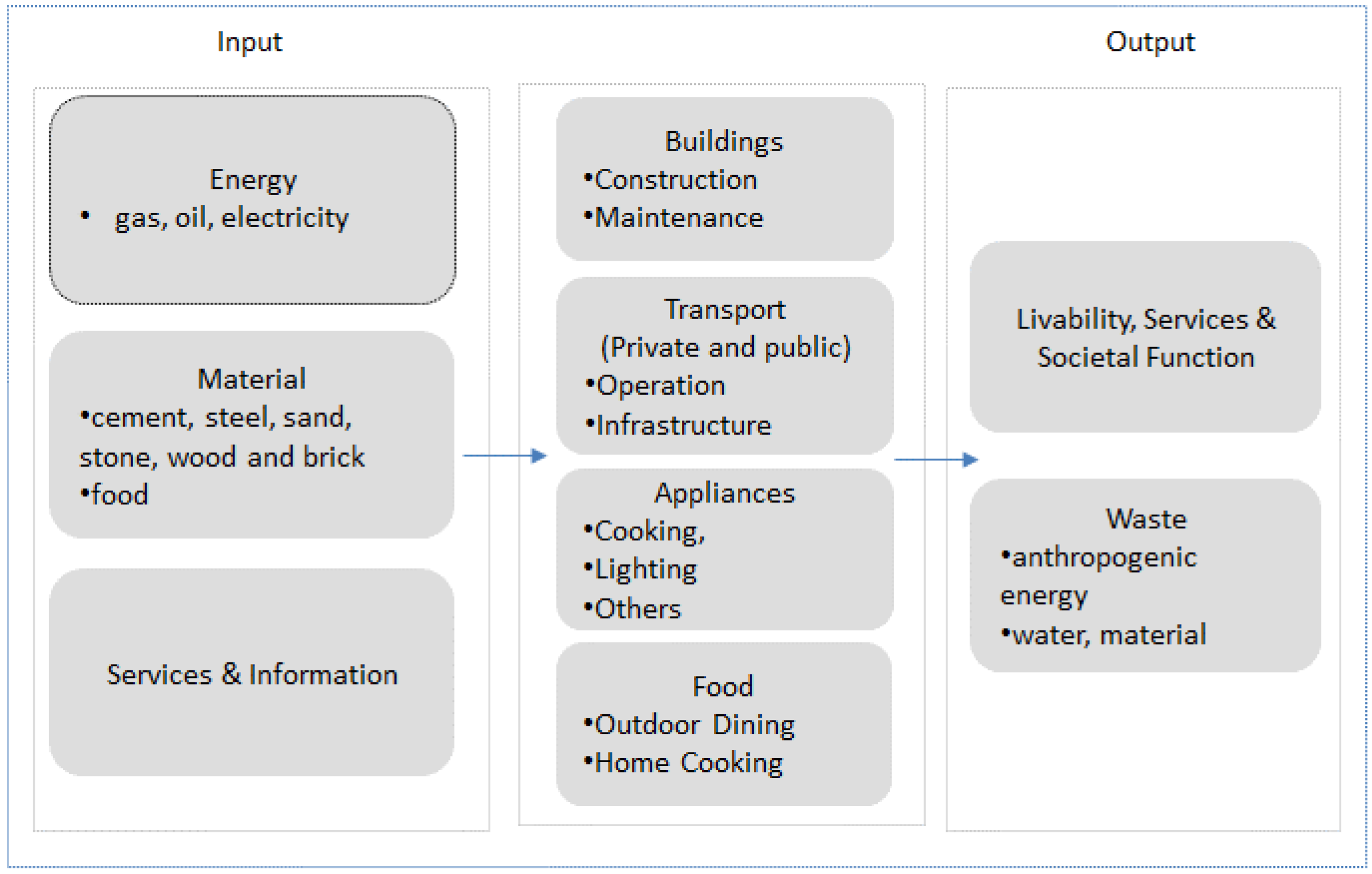
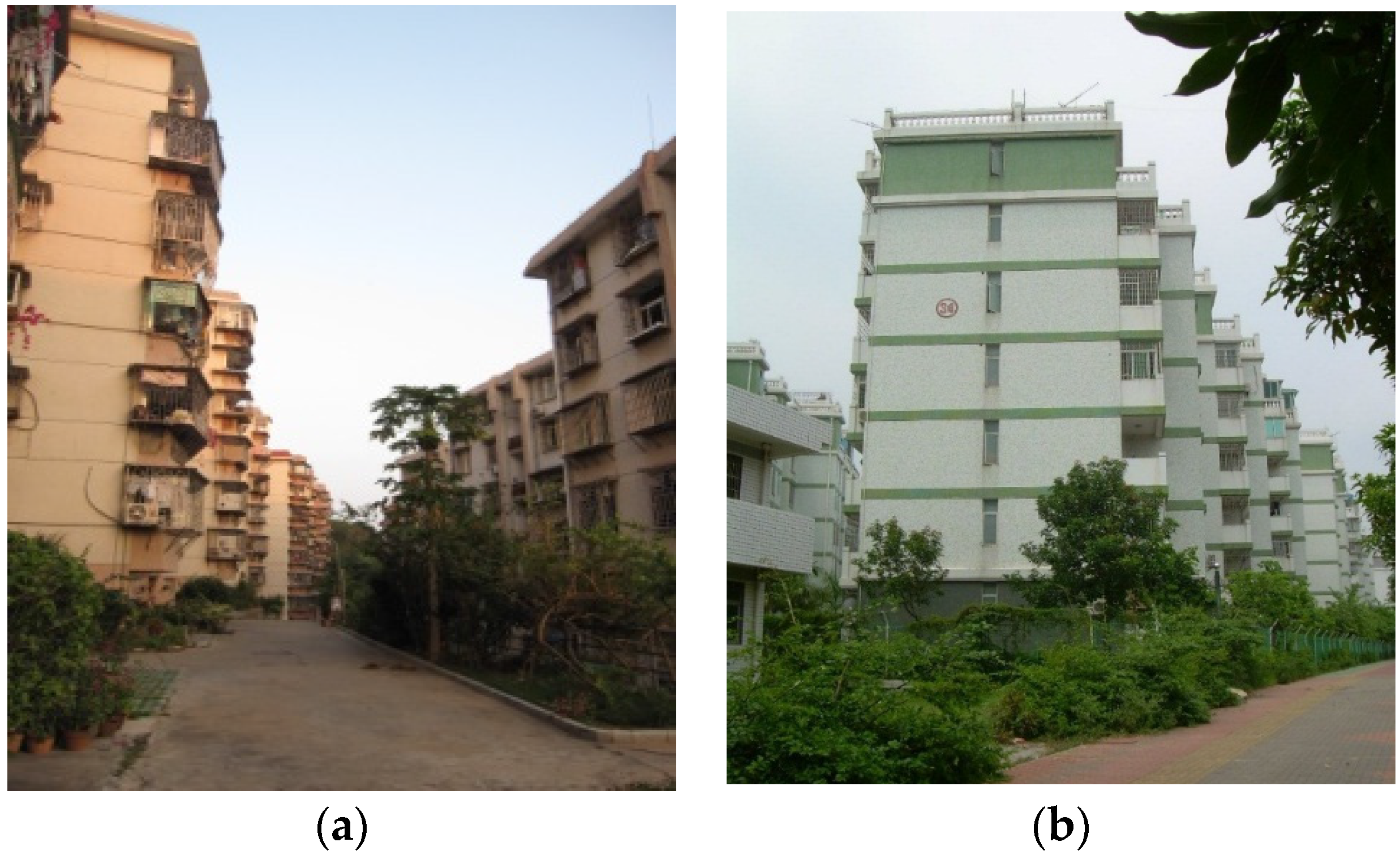
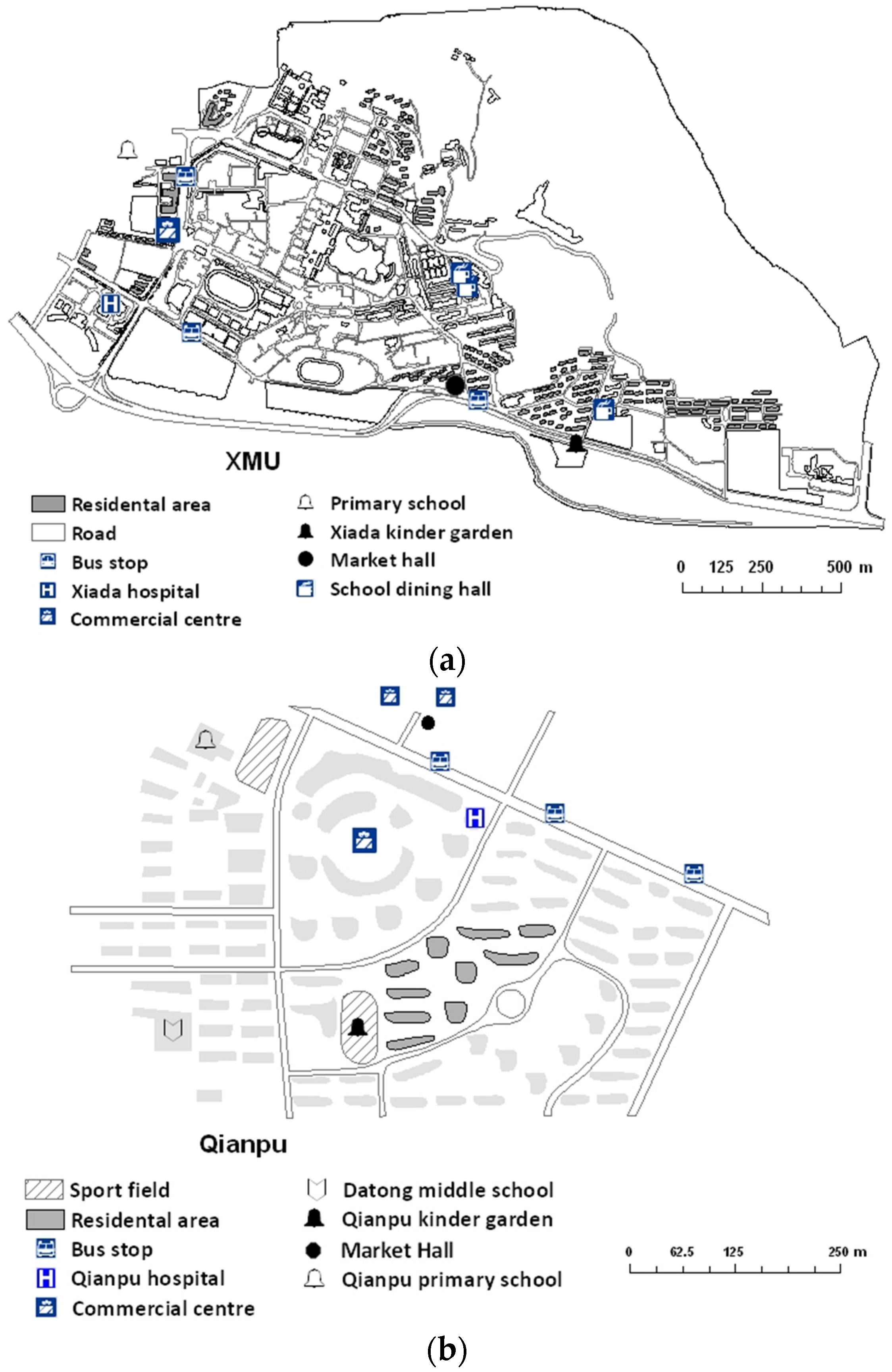
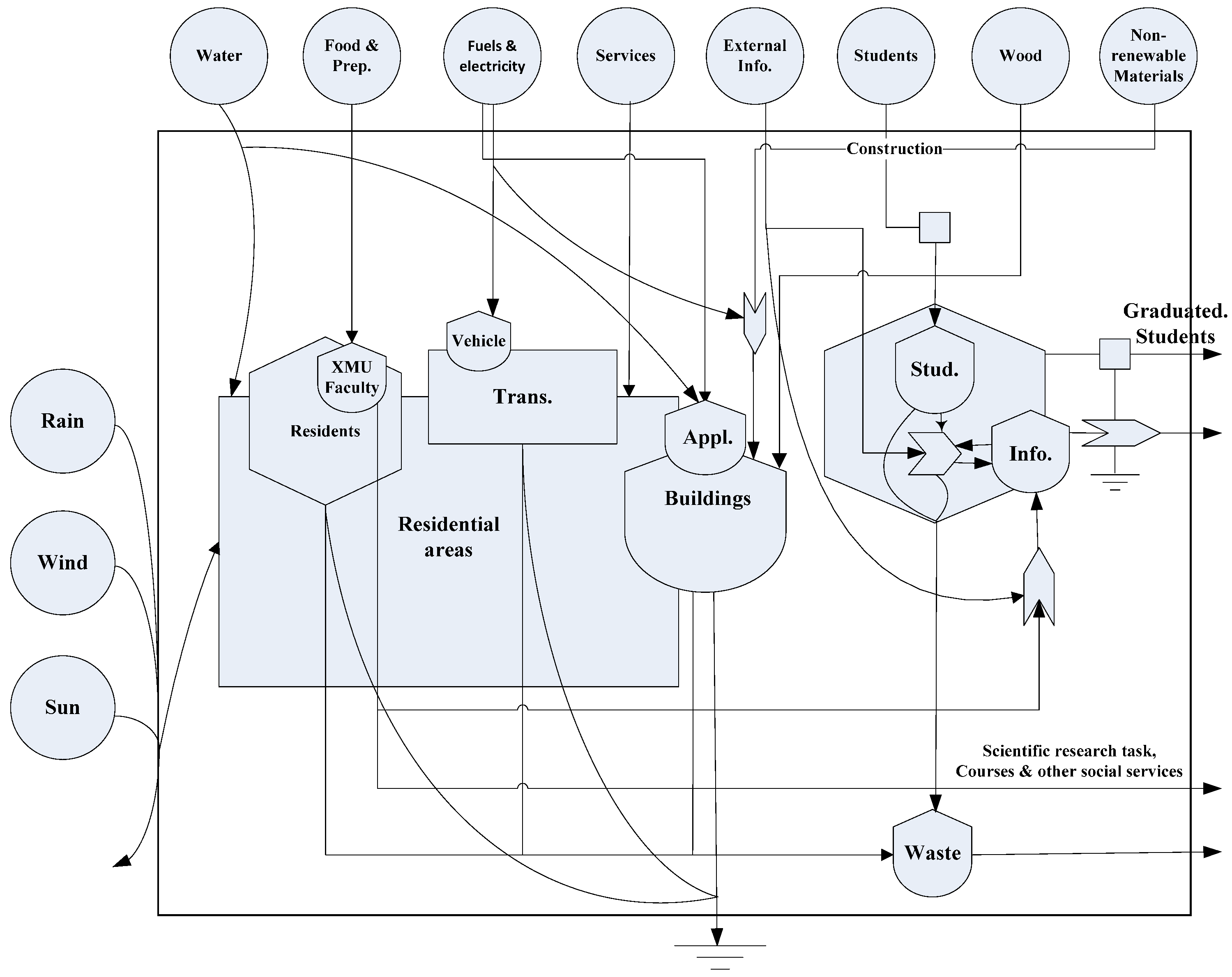
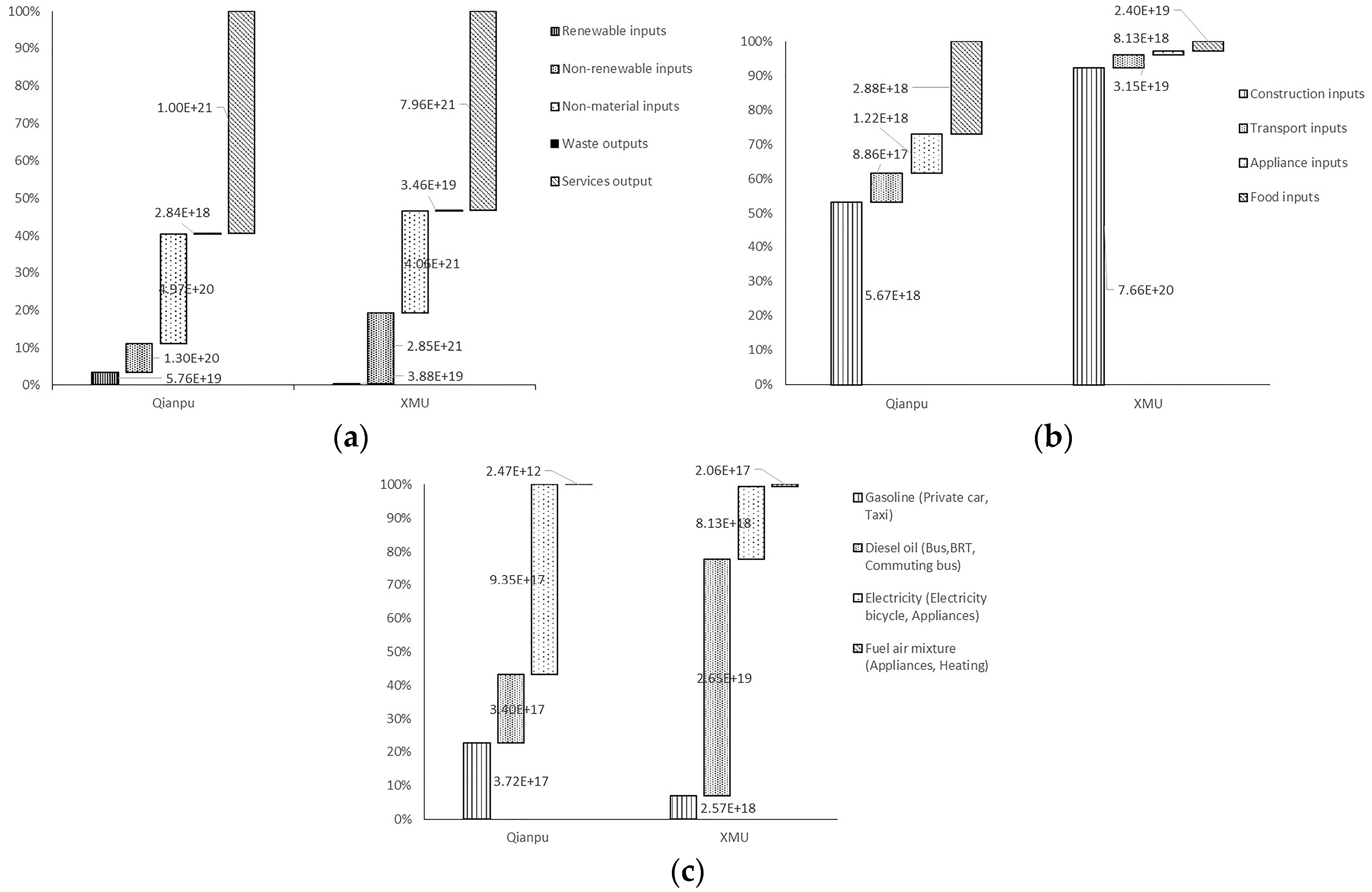
| Information Categories | Content of Survey | |
|---|---|---|
| Socioeconomic | Household size (No. of people), individual and household income, age, gender | |
| Building | Building No., housing area, monthly electricity, water, gas expenditure (CNY/month) | |
| Appliances | ||
| Cooking | Electric cooker | Rated power (kw) |
| Microwave oven | Number, rated power (kw) | |
| Lighting | Electric lights | Rated power (kw) |
| Other appliances | Air conditioning | Number, type, average rated power (kw) |
| Electric/gas water heater | Number, volume, rated power (kw) | |
| Television | Number, rated power (kw), size (inches) | |
| Refrigerator | Number, refrigeration volume (liters) | |
| Washing machine | Number, rated power (kw) | |
| Computer | Number | |
| Transport | ||
| Purpose and destination | Work, school, shopping, entertainment, others | |
| Travel modes | Private car, taxi, Bus Rapid Transport (BRT), ordinary bus, work-unit commuting bus, electric bicycle, bicycle, walking | |
| Travel variables | Trips made daily or monthly, destination of each trip (list at least three), one-way trip time/distance from home | |
| If private car owner | Vehicle displacement, daily vehicle miles or time traveled, fuel use per hkm, monthly vehicle fuel expenditure | |
| Food | ||
| Dining out | Monthly expenditure | |
| Cooking at home | Total monthly expenditure (CNY) | |
| Expenditure on grains, vegetables, meat, fish, eggs, oil, fruit, wine, dairy products, desserts and cakes, cigarettes, tea (CNY/month) | ||
| Place of purchase | ||
| Waste | Daily household waste (kg) | |
| Variable | XMU | Qianpu |
|---|---|---|
| Urban form | ||
| Geographic location on the island | SW | NE |
| Road area (ha) 1 | 3.22 c | 0.63 a |
| Green area (ha) 2 | 6.79 d | 0.73 b |
| Gross floor area (ha) 3 | 22.94 e | 2.15 g |
| Site area (ha) 4 | 2.63 c | 0.50 c |
| Total area (ha) 5 | 12.64 f | 1.87 f |
| Building type | Multistory (1–7) | Multistory and small high-rise |
| Structure of buildings | Brick-concrete | Shear wall (multistory) and frame (small high-rise) |
| Socioeconomic 6 | ||
| Household income (yuan/month) | 6957 | 7250 |
| Housing | ||
| Number of households | 2244 e | 250 |
| Household size (number of persons) 6 | 3.35 | 3.74 |
| Per household living area (m2) 6 | 85 | 112 |
| Per capita living area (m2) 6 | 25.3 | 29.9 |
| Per capita public road area (m2) 6 | 15.3 | 19.1 |
| Per capita gross floor area (m2) 6 | 21.5 | 23.0 |
| Per capita green area (m2) 6 | 6.5 | 7.8 |
| Floor area ratio (%) 7 | 2.1 | 1.5 |
| Household Commuting 6 | ||
| Car possession (%) | 27.8 | 40.7 |
| Commuting mode (walking or electric bicycle %) | 33.5 | 4.4 |
| Commuting mode (motor vehicle %) | 5.8 | 31.6 |
| Commuting distance (average) | 1.5 | 12.0 |
| Appliances 6 | ||
| Number of air conditioning units | 2.0 | 3.2 |
| Number of electric/gas water heater | 1.1 | 1.3 |
| Number of televisions | 2.9 | 1.4 |
| Television size (inches) | 28.0 | 29.7 |
| Number of refrigerators | 2 | 1 |
| Refrigerator volume (liters) | 150 | 223.8 |
| Number of washing machines | 1.0 | 1.1 |
| Emergy Indicators | Explanations | Qianpu | XMU | |
|---|---|---|---|---|
| I. Metabolic efficiency | ||||
| (1) Emergy density | Ratio of total emergy inputs to total area (sej/ha) | Socioeconomic performance of the system | 3.68 × 1016 | 4.89 × 1016 |
| (2) Ratio of input /output | Ratio of emergy inputs to emergy outputs | Metabolism efficiency | 6.82 × 10−1 | 7.74 × 10−1 |
| (3) Ratio of emergy production | Ratio of system output to nonrenewable resources emergy input flows | Higher emergy outputs produced or lower nonrenewable resources used represents efficiency | 7.71 × 100 | 3.89 × 100 |
| II. Resilience and renewability | ||||
| (1) Fraction of self-support | Ratio of indigenous natural resources to total emergy inputs | System self-supportive ability | 7.69 × 10−4 | 5.78 × 10−4 |
| III. Natural resources reliance | ||||
| (1) Percent fuels and electricity (% fuels and electricity) | Ratio of fuels and electricity inputs to total emergy inputs | Reliance to external non-renewable fuel and electricity inputs | 2.40 × 10−3 | 6.07 × 10−3 |
| (2) Percent non-renewable (% Non-renewable) | Ratio of nonrenewable emergy inputs to total emergy inputs | Reliance to external non-renewable material inputs | 1.92 × 10−1 | 3.37 × 10−3 |
| IV. Waste and environmental burden | ||||
| (1) Waste to renewable Ratio | Ratio of waste emergy outputs to renewable natural resources emergy input | System recycling ability and recycling pressure posed by waste output | 4.92 × 10−2 | 8.60 × 10−1 |
| (2) Percent waste (% waste) | Ratio of waste emergy outputs to total emergy inputs | System environmental pressure posed by waste output | 4.14 × 10−3 | 5.59 × 10−3 |
| (3) Environmental load ratio (ELR) | Ratio of nonrenewable resources emergy flows to local indigenous natural resources inputs | Environmental stress due to nonrenewable production | 2.50 × 102 | 5.84 × 102 |
| V. Welfare | ||||
| (1) Per capita emergy use | Per capita emergy inputs (sej/person) | Emergy welfare | 7.34 × 1017 | 5.79 × 1017 |
| (2) Per capita material use | Per capita material inputs (sej/person) | Material welfare | 2.01 × 1017 | 1.95 × 1017 |
| (3) Per capita fuels and electricity use | Per capita fuels and electricity inputs (sej/person) | Fuels and electricity welfare | 1.76 × 1015 | 3.52 × 1015 |
| (4) Per capita construction use | Per capita construction inputs(sej/person) | Construction welfare | 6.07 × 1015 | 7.18 × 1016 |
| (5) Per capita infrastructure use | Per capital transport infrastructure and fuel inputs (sej/person) | Transport infrastructure welfare | 9.47 × 1014 | 2.95 × 1015 |
| (6) Per capita service use | Per capita service inputs (sej/person) | Service emergy consumed by residents for the better livability | 3.28 × 1015 | 7.26 × 1014 |
| (7) Services input | Ratio of service input to total emergy inputs | Reliance to labor power and other services input | 4.47 × 10−3 | 1.25 × 10−3 |
© 2016 by the authors; licensee MDPI, Basel, Switzerland. This article is an open access article distributed under the terms and conditions of the Creative Commons Attribution (CC-BY) license (http://creativecommons.org/licenses/by/4.0/).
Share and Cite
Gao, L.; Cui, S.; Yang, D.; Tang, L.; Vause, J.; Xiao, L.; Li, X.; Shi, L. Sustainability and Chinese Urban Settlements: Extending the Metabolism Model of Emergy Evaluation. Sustainability 2016, 8, 459. https://doi.org/10.3390/su8050459
Gao L, Cui S, Yang D, Tang L, Vause J, Xiao L, Li X, Shi L. Sustainability and Chinese Urban Settlements: Extending the Metabolism Model of Emergy Evaluation. Sustainability. 2016; 8(5):459. https://doi.org/10.3390/su8050459
Chicago/Turabian StyleGao, Lijie, Shenghui Cui, Dewei Yang, Lina Tang, Jonathan Vause, Lishan Xiao, Xuanqi Li, and Longyu Shi. 2016. "Sustainability and Chinese Urban Settlements: Extending the Metabolism Model of Emergy Evaluation" Sustainability 8, no. 5: 459. https://doi.org/10.3390/su8050459





